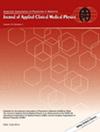Shielding resources for four common radiopharmaceuticals utilized for imaging and therapy: Tc-99m, F-18, I-131, and Lu-177
Abstract
Introduction
The use of radioactive materials in the United States has been tightly regulated by the Nuclear Regulatory Commission and other entities for many decades. In 2015, however, the Joint Commission began to require hospital-based nuclear medicine departments to conduct shielding designs and evaluations for radioactive material areas, mirroring established x-ray practices. NCRP Report No. 147 guides diagnostic medical x-ray shielding, but obviously cannot be used alone for nuclear medicine applications. The rising demand for theranostic nuclear medicine shielding evaluations particularly necessitates updated focused guidance, the aim of this report.
Methods
Monte Carlo simulations were conducted using GATE software to analyze the effects of various barriers on the transmission of radioactive emissions. The simulations used point sources of Tc-99m, F-18, I-131, and Lu-177 and evaluated dose deposition to blocks of tissue using Dose Actors. Different ceiling heights (ranging from 10–16 feet) were also tested for scattering effects. The Archer equation was employed to fit transmission curves and estimate required barrier thicknesses.
Results
Broad beam transmission factors and Archer fitting parameters are reported for various materials including lead, gypsum, concrete (light weight and normal weight), glass, and steel. A sample shielding calculation is provided for a wall separating Lu-177 dotatate patients from an adjacent office to maintain public dose limits. Relevant occupancy factors are also provided.
Conclusions
While Lu-177 has a relatively low exposure rate constant, shielding may be necessary for high-volume therapies like Lu-177 DOTATATE and Lu-177 vipivotide tetraxetan PSMA. Shielding involves accounting for broad radiation beams and requires thorough characterization of radiation buildup. When shielding to the typical height of 7 feet, scatter from ceilings and floors is negligible for transmission above 10%, but severely limits the ability to shield for transmission below 1%.


 求助内容:
求助内容: 应助结果提醒方式:
应助结果提醒方式:


